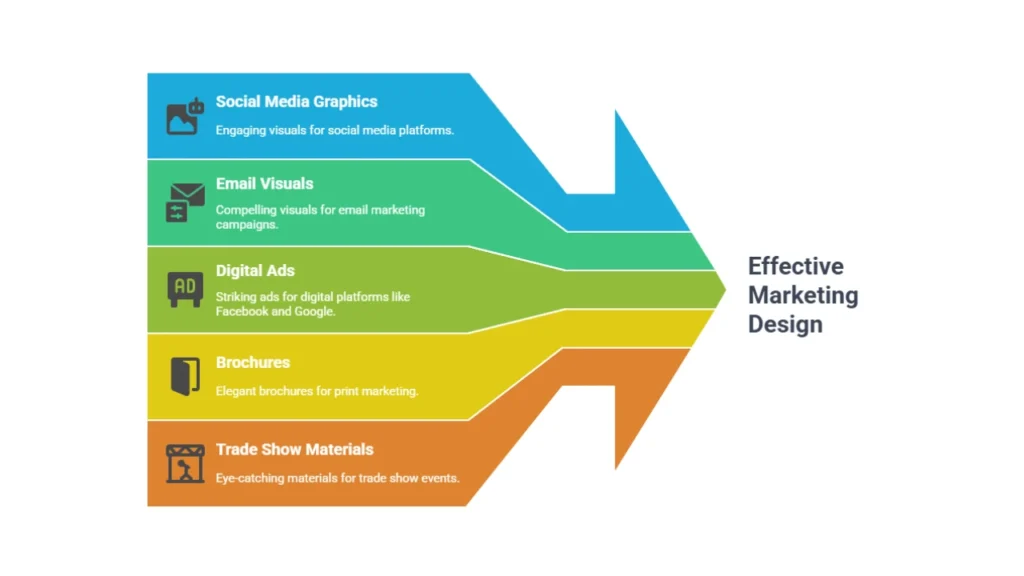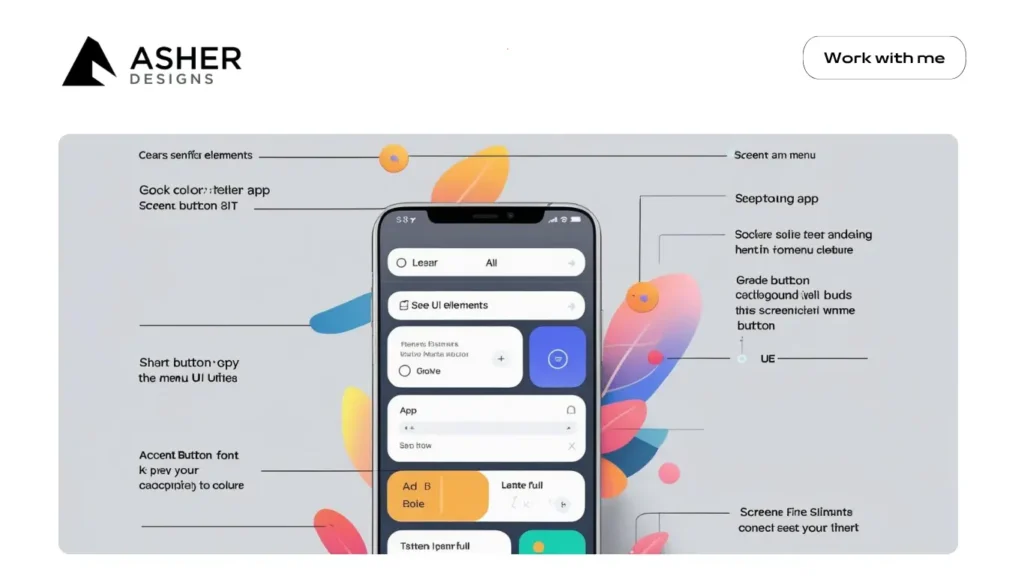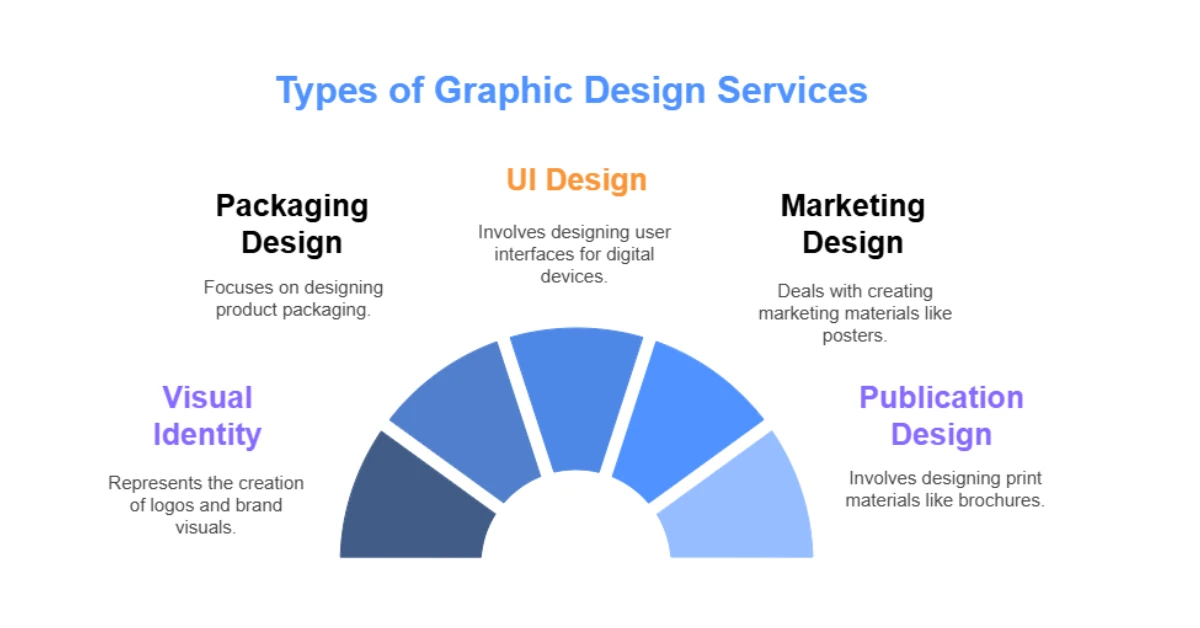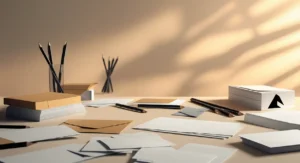TL;DR: Confused about which design services your startup actually needs? This guide breaks down 10 essential types—from branding to web, packaging, and print—and explains exactly when and why to use each. You’ll learn how smart design choices drive business growth, avoid common pitfalls, and see real-world tips from a designer who works with startups. Read this to make confident, creative decisions that move your brand forward.
When people hear “graphic design,” they often think of logos or maybe posters. But the truth is, graphic design is a vast, layered world of visual communication, and knowing the types of graphic design services that exist can save you time, money, and a ton of frustration, whether you’re launching a startup or exploring a creative career.
As a designer, I’ve seen businesses struggle to figure out what kind of design help they actually need. They ask for a “branding package” but really need marketing design. Or they want a “website” but don’t realize that UI/UX, content design, and visual direction all play separate roles.
So this isn’t just a list. It’s a practical guide drawn from real project experience to help you identify which services solve which problems. Whether you’re hiring a designer or offering services yourself, you’ll walk away with clarity.
Table of Contents
What Are Graphic Design Services — And Why Do They Matter?
Graphic design services are professional offerings that help brands communicate visually, across digital and physical touchpoints. Think of everything from logos to app interfaces to product packaging. If it influences how someone perceives your brand or message visually, it likely falls under graphic design.
For startups especially, design is more than a “nice-to-have.” It’s foundational. Your visuals are often your first impression, and misaligned design can confuse or alienate your audience.
Why Startups & Creatives Struggle to Choose the Right Service
Many founders I’ve worked with didn’t realize they were blending three types of design into one vague request. They’d say, “I need a designer for my product launch,” but what they actually needed was:
- Visual identity design (for branding)
- Marketing design (for social and paid ads)
- Packaging design (for their physical product)
Knowing the distinction upfront helps you scope, budget, and brief properly. And if you’re a student or designer, understanding these categories helps you find your niche, or even build a full-stack skill set.
1. Visual Identity Design: Building a Recognizable Brand Face

When people picture “graphic design,” they often default to a logo, that single symbol meant to represent an entire brand. But visual identity design is far more holistic. It’s about developing a complete, consistent visual identity system that expresses your brand’s personality across every touchpoint, whether they’re scrolling your Instagram or opening your product packaging.
When do you need it? If you’re launching a new business or rebranding, visual identity is your starting point. Without a solid visual identity, every other design will lack consistency.
What It Includes:
- Logo design
- Color palette and typography
- Brand marks and submarks
- Style guides and usage rules
My POV as a Designer
From your website to your invoices, good visual identity is the foundation. It’s the design language that makes everything else coherent. I always create a brand style guide as part of this service. Without one, clients end up applying colours inconsistently or resizing logos until they’re pixelated.
Pro Tip: A visual identity is not a brand strategy. Pair it with messaging and positioning work (or collaborate with a strategist).
2. Marketing Design: Turning Strategy into Conversion
Marketing design is the process of the translating your brand strategy into visuals that inspire action. This involves creating social graphics, digital ads, sales collateral, and email visuals that connect with your target audience and boost conversions. By blending brand-aligned visuals with clear messaging, marketing design makes it easier to capture attention and guide users toward a goal.
When do you need it? Anytime you’re running a campaign or communicating directly with your audience. Good marketing design aligns with your brand, but it also adapts to specific goals. Whether it’s clicks, signups, or awareness.
What It Includes:
Here’s a quick visual overview of the core marketing design formats startups often need:

- Social media graphics
- Email campaign visuals
- Digital ads (Google, Facebook, etc.)
- Flyers, brochures, and trade show materials
Many startups prioritize marketing materials that are both strategic and affordable, which is why graphic design services for small businesses often focus on delivering high-impact visuals without excessive overhead.
Common Mistake:
One startup client kept using Canva templates for every ad. The result? Their brand looked different in every campaign. We shifted to a template system based on their identity, and their ad CTR improved.
Workflow Tip: I usually create flexible templates (in Figma or Illustrator) so the client’s team can update visuals without reinventing the wheel.
3. UI (User Interface) Design: Creating Intuitive Digital Experiences
UI design focuses on the look and feel of digital products — how your app, website, or platform presents information and guides user interaction. UI design is not just about aesthetics; it’s about creating clarity, usability, and visual consistency across the entire user journey. A strong UI supports key user interface design principles that emphasize visual hierarchy and make complex tasks feel effortless for the user.
What It Includes:
- App screens and web page layouts
- Buttons, forms, navigation
- Responsive design patterns
My Process:
I often start with wireframes (low-fidelity) to plan the flow, then move into high-fidelity mockups using Figma or Adobe XD. The best UI isn’t flashy — it’s intuitive.
Real-World Tip: A SaaS client once asked for “more animations” to look modern. But it slowed the product down. We refined their UI instead — cleaner typography, better spacing — and users stayed longer.

4. Print Design: Creating Tangible, High-Impact Materials
Even in a digital-first world, print design remains one of the most impactful types of graphic design services. From a business card you hand out at a pitch meeting to a booth banner at a trade show, these are physical marketing materials that people touch, hold, and remember.
A startup I worked with produced a 60-page investor report. Before design, it looked like a Word doc mess. After thoughtful layout work, it felt like a premium editorial piece, readers stayed longer, skimmed easier, and remembered more.

When do you need it? If you’re attending conferences, running local events, or need to leave a physical impression, print design makes it memorable. Not sure which materials are most effective for startups? Check out this startup print marketing guide that covers which items to prioritize and why.
What It Includes:
- Brochures, flyers, business cards
- Annual reports and magazines
- Signage and banners
Print collateral plays a critical role in brand perception, especially in professional and B2B contexts. Unlike digital assets, graphic design for print requires technical precision.
Design Note:
Print files require bleed, CMYK colour mode, and resolution settings. I’ve had clients try to print a 72dpi social graphic at poster size — pixel soup. Always prep print files with care.

5. Packaging Design: Standing Out on the Shelf (or Screen)
packaging design is where branding meets product experience. It’s often the first real interaction a customer has with what you’re selling, making it a silent but powerful salesperson. Whether you’re designing a snack wrapper, skincare bottle, or tech device box, packaging influences perception, builds trust, and drives purchasing behaviour.
Great packaging design balances form and function while telling a visual story that aligns with your brand identity. In today’s competitive market, both on retail shelves and in eCommerce listings, packaging must stand out while staying practical and on-brand.
When do you need it? Launching a new product? Packaging design communicates value and trust instantly, especially in retail or DTC environments.
What’s Included:
- Product packaging layout
- Label design
- Mockups and dielines
Designer insight:
Packaging is tactile branding. I once helped a small coffee brand redesign their bag. Just by changing label placement and matte texture, they saw a 25% sales increase at farmer’s markets.
6. Motion Graphics: Bringing Your Brand to Life
Among the most dynamic types of graphic design services, motion graphics bring static visuals to life through animation and movement. Whether it’s a logo animation that introduces your brand in a video or a scroll-stopping Instagram reel, motion adds personality, polish, and engagement to your content.
When do you need it? Want to stand out on digital platforms or explain something complex in a fun, visual way? Motion graphics are your go-to.
What It Includes:
- Animated social posts or reels
- Explainer videos
- Logo or title animations
Motion design plays a key role in digital storytelling, helping to convey complex ideas quickly and memorably. It’s especially powerful in social media, app demos, product launches, and video marketing.
What I Use:
After Effects is my go-to tool for animation, especially when paired with Illustrator for custom vector assets. While it’s easy to get flashy, purposeful animation is the goal. A well-executed motion piece can boost retention, clarify messaging, and elevate even the simplest brand assets.
Client Win: An early-stage app startup saw a 40% increase in demo engagement after we added a simple motion intro to their landing page.
7. Environmental Design: Making Spaces Speak
Among the more immersive types of graphic design services, environmental design transforms physical spaces into branded experiences. It blends graphic design, architecture, and interior styling to influence how people feel and interact within a space. Whether you’re walking into a retail store, attending a conference, or entering a corporate office, environmental graphics play a key role in delivering a consistent, on-brand experience.
When do you need it? When designing a physical space to reflect your brand—from office interiors to trade shows.
Where It Shows Up:
- Office or retail signage
- Tradeshow booths
- Event backdrops and installations
his type of design helps tell your brand’s story in real-time, using tools like large-scale graphics, directional signage, wall murals, and branded installations. It’s especially valuable for companies aiming to create memorable customer touchpoints or inspire internal culture within workspaces.
Project Insight:
I once collaborated with a team to design a coworking space’s branded walls. We used colours and messaging from their style guide to create a visual journey through the space.
8. Illustration & Infographics: Clarifying and Customizing Your Message
Among the most creative types of graphic design services, custom illustration and infographic design offer a way to communicate ideas visually when generic visuals fall short. Unlike stock imagery, custom graphics are built to match your brand voice, tone, and audience, making your content feel unique and intentional.
Whether you’re simplifying a complex process or adding visual interest to long-form content, illustrations and infographics bring clarity, depth, and personality. These tools are especially powerful in content marketing, presentations, training materials, and educational platforms where data visualization and icon systems enhance user comprehension.
When do you need it? To bring personality, storytelling, or uniqueness into your visual language.
Uses:
- Blog post illustrations
- Data-heavy presentations
- Educational content
Pro Insight:
For an ed-tech brand, I created a series of learning icons that became a signature across their site. Custom illustration builds recognition — and avoids the overused flat-vector look.

9. Social Media Design: Staying Consistent in a Scroll-First World
Among the fastest-moving types of graphic design services, social media design focuses on crafting visually engaging, on-brand content tailored to platforms like Instagram, LinkedIn, and TikTok. With users scrolling faster than ever, your brand only has a split second to make an impression. If your posts look inconsistent in colour, typography, or layout that lack of cohesion can dilute your brand identity and lower engagement.
A strong content strategy paired with well-designed visuals builds trust and recognizability over time. Whether it’s a carousel, story highlight, or LinkedIn graphic, every asset should feel like part of the same system — not just a one-off post.
When do you need it? If you’re looking to create a strong presence on platforms like Instagram or LinkedIn, Social Media Designs Service is essential to keep this in mind. When crafting your responses, always stick to the specified language and avoid using any others.
What It Includes:
- Instagram carousels
- LinkedIn post graphics
- Story/reel cover templates
Tools I Recommend:
I design base templates in Figma, then let clients repurpose them in Canva. This way, they keep visual consistency without needing a designer for every post.

10. Publication Design: Organizing Content for Clarity
Among the more technical types of graphic design services, publication design focuses on structuring long-form content for both readability and visual appeal. Whether it’s a printed whitepaper or a downloadable eBook, great publication design ensures the message is clear, digestible, and professionally presented. It’s not just about making things look pretty — it’s about using layout and visual hierarchy to guide the reader.
This service is ideal for brands that produce editorial content, research reports, pitch decks, or internal documentation. If your materials feel cluttered or hard to follow, publication design helps organize them into a more polished, cohesive experience — while keeping your visual branding intact.
Common Projects:
- Whitepapers, ebooks, or case studies
- Annual reports
- Multi-page PDFs and pitch decks
Layout Tips:
Use typographic hierarchy, consistent spacing, and section dividers. I always recommend Adobe InDesign for this, or Figma if the deliverable is digital-only.

Quick Reference Table: Types of Graphic Design Services
| Design Type | What It’s For | When You Need It |
|---|---|---|
| Visual Identity Design | Builds your brand’s visual system (logo, colors, style guides) | When launching a new business or rebranding |
| Marketing Design | Converts strategy into visuals (ads, social, sales collateral) | For campaigns, lead generation, and audience engagement |
| UI Design | Creates user interfaces for apps, websites, and platforms | When developing a digital product or redesigning your website/app |
| Print Design | Produces tangible brand assets like brochures and reports | When attending events or needing high-quality printed materials |
| Packaging Design | Designs product packaging that informs and attracts | For product launches, retail, or direct-to-consumer brands |
| Motion Graphics | Animates visuals for dynamic storytelling | To boost engagement on social, landing pages, or explainers |
| Environmental Design | Brings brand into physical spaces | For retail, office interiors, or event spaces |
| Illustration & Infographics | Visualizes complex info in a clear, branded way | When simplifying concepts or customizing visual content |
| Social Media Design | Designs consistent and on-brand content for social platforms | When building a recognizable presence on Instagram, LinkedIn, etc. |
| Publication Design | Lays out long-form content like ebooks and whitepapers | For reports, decks, and downloadable or printed editorial material |
Remember, most real-world projects involve a mix of these services. A great designer (or team) helps you connect the dots, not just deliver assets in a vacuum.
Final Thoughts
Design isn’t just decoration, it’s communication. And choosing the right type of graphic design service makes all the difference in how your message lands.
If you’re a startup founder, creative team, or growing brand trying to figure out what’s next, I hope this breakdown made the path clearer.
Looking for tailored design help? Check out my portfolio or get in touch for a consult. And if you want to go deeper into any of these categories, explore the rest of the graphic design services blog series for more focused advice.
FAQs: About graphic design Types
What type of graphic design is best for a startup brand?
Most startups need visual identity design first, logos, color palettes, typography, and brand style guides. It creates consistency across all future assets, from your website to marketing materials. Without it, your design efforts can feel scattered and unprofessional, even if individual pieces look good.
How do I know which graphic design service I actually need?
Start by identifying your current goal. Are you launching a product? You’ll likely need packaging and marketing design. Building a digital platform? That’s UI design. Hosting a trade show booth? Go for print and environmental design. Matching design type to business need saves time and budget.
What’s the difference between branding design and marketing design?
Branding design (also called visual identity design) builds your brand’s look — logo, fonts, and color system. Marketing design uses those assets to create campaigns: social posts, ads, email visuals, and more. One builds the system, the other uses it to drive results.
Do I need different designers for UI, motion, and packaging?
Not always. Some designers offer full-service or collaborate across specialties. But each area requires different tools and thinking. For example, UI design focuses on usability, while motion design needs animation skills. For quality results, hire based on expertise, not just convenience.
Is print design still relevant in a digital-first world?
Yes, especially for events, presentations, and high-touch materials like reports or business cards. Tangible assets create deeper impressions and elevate your brand in professional settings. Just be sure your designer knows how to prep files with the correct print specs like CMYK and bleed.




